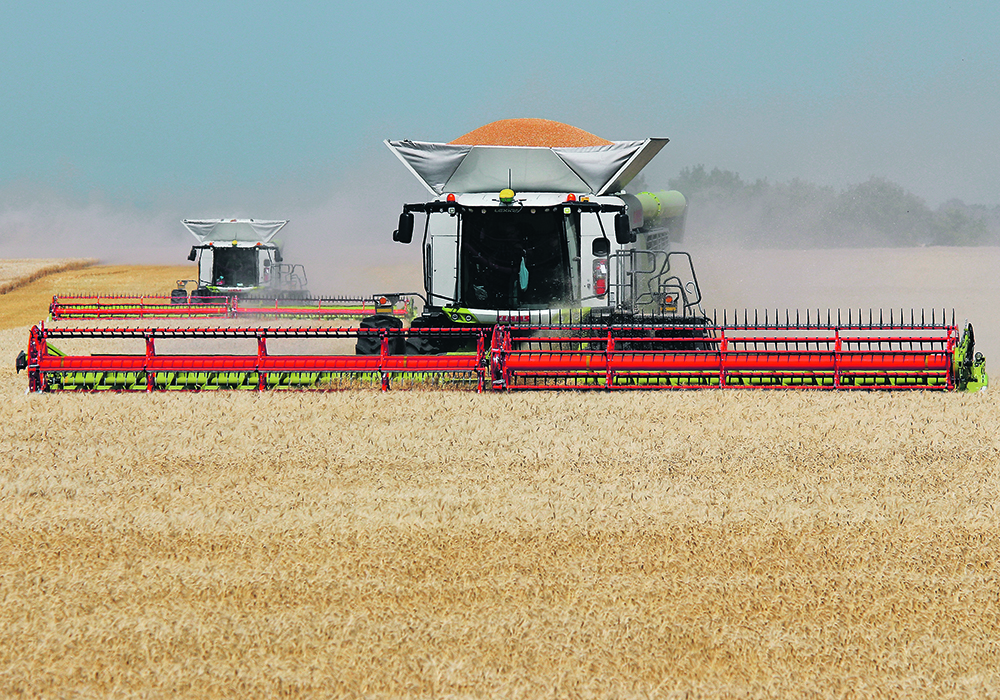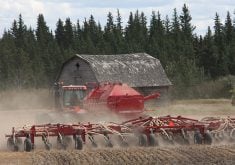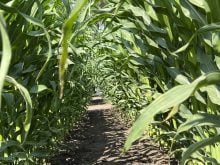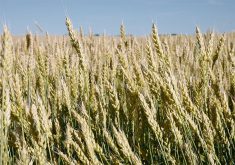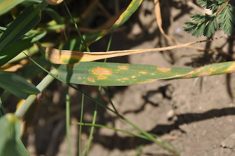Research bumps winter wheat crop insurance deadline a whole month to allow more farmers to plant the “cover crop”
Winter wheat growers traditionally like seeding into canola stubble, something that becomes a problem when harvest runs late and pushes up against the crop insurance seeding cut-off date of September 1.
The equation can be made worse by some growers deliberately planting canola later to avoid frost damage and flea beetles or to chase higher yields with longer-season varieties.
It’s a predicament Riceton, Sask. canola grower Lee Moats experiences every fall. He gets a first-hand look at canola varieties from the plots on his farm and sees the considerable variation among early and late varieties. There’s a strong correlation between early maturity and yield: the later the variety, the greater the bushels.
“Late-maturity canola is a prime reason farmers cannot get their winter wheat planted,” Moats said. “In our case, we grow specialty oil canola. There are very few variety choices, late maturity in all cases. The competing timeline objectives of high-yield canola and winter wheat creates some real challenges for us.”
As a consequence, potential winter wheat growers weigh the benefits against the risks of the fall-seeded crop then consider the prospect of zero crop insurance because of a missed deadline. The conclusion is often: “No insurance? No thanks.”
Moats was a Ducks Unlimited agronomist for 20 years and as such was heavily involved in its winter wheat program. The organization offers a $20 per acre incentive to encourage growers to try a fall-seeded crop and in the process create waterfowl-friendly habitat on their land. The program covers up to 250 acres to a maximum of $5,000.
Ducks Unlimited was one of several that helped crop insurance corporations across the three prairie provinces widen their winter wheat sowing windows. The cut-off date has been moved from September 1 to the end of September.
Changing a seeding deadline by a whole month was not trivial. Insurance underwriters thrive on data: weather, crop variety, soil, seeding dates, seeding equipment and more.
To get it, researchers backed by the University of Manitoba, Western Ag, Bayer Crop Sciences, Ducks Unlimited, Ag Canada and a host of other partners went out to get muddy collecting data on winter wheat seeding dates.
University of Manitoba agronomist Yvonne Lawley led the project.
“Growers knew that September 1 was no longer realistic,” she said. “It may have been valid 20 or 30 years before but not with today’s varieties and better management practices.”
Making winter wheat a more viable alternative would allow farmers to reap the crop’s known benefits, such as spreading out demands on machinery and labour, plus putting something in the ground that will get the jump on competition in the spring.
For Lawley, soil protection also ranks high on the list. She explained that many fields are left unprotected after the harvest, especially with crops such as canola, soybean and pulse crops that leave little residue behind for soil microorganisms to feed upon.
“To me, the next big question on the value of winter wheat in western Canada isn’t risk management,” she said. “I think of winter wheat as a cover crop. Winter wheat is our best cover crop. Fall is the time we really need to protect our soils. In a cropping system, there’s no better option than a fall-seeded cover crop.”
New, shorter winter wheat varieties are also making the crop more attractive with better resistance to both disease and lodging. Ducks Unlimited agrologist Ken Gross said the organization has put $2.5 million into winter wheat variety development on top of expenditures in agronomic research and extension.
“Growers in recent years have had good results with Wildfire,” Gross said. “But lately there are new varieties coming down the pipe and they look better than Wildfire. Falcon is about the shortest variety we ever had but it’s obsolete now. Gateway looks really good. It’s a couple inches taller than the old CDC Falcon variety. Emerson and Goldrush are the other popular varieties.”
So how does winter wheat pencil out for profitability?
Ducks Unlimited reports that winter wheat is the most profitable cereal for farmers in their incentive program, which on top of its $20 per acre also includes fertility advice from Western Ag using the Plant Root Simulators, CropCasting and access to GrainFox, FarmLink’s marketing tool.
As for yields, in Manitoba at least, many producers saw 85 bushels per acre in 2022 with $12 per bushel prices. In the past two years, half the growers in the Ducks Unlimited program saw yields above 70 bushels per acre or better.
“We grew an average 97 bushels per acre with some zones pushing close to 120 bushels,” said Neepawa farmer Stephane Lapointe, a winter wheat grower for 20 years.
“2022 was pretty much a record yield for us.”
Lapointe routinely seeds winter wheat into barley stubble since the two cereals aren’t susceptible to the same diseases and the fall-seeded crop out-competes hard-to-control barley volunteers.
Research at Agriculture Canada’s Lethbridge Research and Development Centre shows the crop can be an effective tool in controlling kochia as well.
“Kochia biomass was 72 percent lower in the rotations with winter wheat,” said Ag Canada researcher Charles Geddes. “We found an average 60 percent lower kochia density in the rotations with winter wheat.”
How late can fall seeding go? Lawley and her colleagues gathered data from 2013 to 2018 on sites in all regions across the Prairies. They also talked to experienced growers accustomed to planting winter wheat right up to snowfall.
They found that there’s a lot more straight-cut canola and that pushes harvest into September as does the increase in longer-season hybrids. Demanding that farmers get their winter wheat in the ground before the September 1 cut off doesn’t just narrow the seeding window, it slams it shut without good reason.
“Our data shows there’s a slight yield decline as seeding dates extend deeper into the fall season. But if you can get 98 percent of your top yield, will you go ahead and plant winter wheat? What about 90 percent? Or 85 percent of target?”

Lawley explained that their research charted the curve of how planting date affects yield. While the optimum seeding dates stay the same, producers can now look at the trade-offs and make an informed decision.
“So it’s September and you have your soil profile with not much moisture. Are you going to put winter wheat into that dry soil? Or is your thinking just the opposite? Are you thinking ‘I know I’m going to get snow. If I can just get a stand growing it’ll take care of itself.’”
The latest seeding date the researchers documented in their trials was November 1. In these scenarios the seed vernalizes, imbibing water from the soil but remaining dormant over the winter before coming to life with spring’s sunshine.
“This was the riskiest treatment we tried,” Lawley said. “I will say that planting winter wheat in November did succeed at many site years. Would I recommend November planting? No. You have to be very careful about the conditions to make it work.
“We would like to know the impact of our research. We had barely released our conclusions and then we went into our prairie drought period. So we’re anxious for any feedback.”


